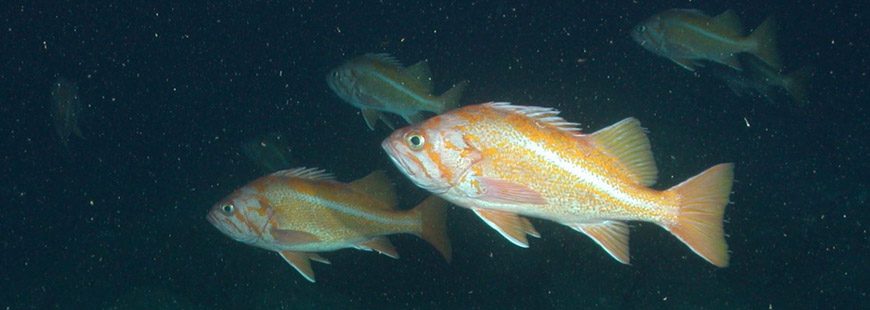Photo: Canary Rockfish, courtesy of NOAA.
My August blog post focused on the great progress the Magnuson-Stevens Act (MSA) has made in rebuilding important species in the Gulf of Mexico. A similar story can be told of the Pacific Northwest. In fact, the productivity of fish and shellfish in this region, thanks to the MSA, makes it the marine equivalent of the Midwest’s “breadbasket.”
According to NOAA’s 2014 Fisheries Economics of the U.S. (FEUS), the Pacific region supports the nation’s largest commercial fishing sector. NOAA measures this by calculating the ratio of jobs in a state’s commercial fishing sector relative to the size of the commercial fishing sector in the nation’s overall economy. The higher the number for a state, the more commercial fishing jobs there are. This quotient is termed the Commercial Fishing Location Quotient, or CFLQ. The national CFLQ equaled 1 in 2013. In Washington State, however, the CFLQ was a staggering 14.13 and Oregon’s was 4.07.
The robust fisheries sector in the Northwest serves as an important economic driver. According to FEUS, revenue from landings for 2014 totaled $754 million, an overall upward trend from 2005. Total catch, however, was slightly down between 2005 and 2014, but still over 1 billion pounds of fish and shellfish was taken in 2014. Higher revenue from this sector resulted from gradual increases in prices per pound for the period for all key species of fish and shellfish tracked by the FEUS report. Fisheries also mean jobs. The commercial sector employed almost 227,000 although a large portion can be attributed to the fish import businesses in California.
Part of the success in the Pacific Northwest comes from the regional council’s ecosystem-wide approach to fisheries. The council has not only used the law to bring back overfished commercial stocks but also to conserve important species that had been previously ignored.
Several years ago, fisheries managers and scientists began studying the interrelations of species along the Pacific coast. They noted that larger, commercially important fish depended on small, seemingly insignificant prey. Closer study showed that these tiny, schooling fish were the linchpin between the available nutrition of microscopic organisms at the bottom of the food web and all of the larger, commercially important marine species. Without the small forage fish, larger predators would have no access to the energy contained in the billions of cubic tons of plankton and other miniscule life forms.
In response to this realization, the Pacific Fishery Management Council this year took the farsighted step of banning new commercial fisheries for forage fish that were not yet managed by the MSA. The regulation does not affect existing fisheries for sardines, anchovies, and other designated stocks, nor does it apply to fishing by Native Americans. In addition, it pertains only to federal waters 3 to 200 miles from the coast. The benefits of this measure ripple out far and wide, conserving a source of food for sea birds, many mammals, and coastal wildlife.
The Magnuson-Stevens Act gave managers the flexibility to adopt a holistic management plan for forage fish. In the same fashion the Pacific Fishery Management Council used the Act to rebuild two very important commercial groundfish stocks: canary rockfish and petrale sole.
The council has worked for 15 years to bring these fisheries back, both of which had been listed as overfished. The rebuilding process was expected to take 26 years, but the council’s decisive action based on MSA’s provisions and the fishing community’s invaluable cooperation moved these species off the list several years ahead of schedule.
The work required significant sacrifices. Overfished canary rockfish co-exist with many healthy groundfish stocks. The regulations needed to bring this stock back also applied to these healthy species. This resulted in hardships for fishermen targeting plentiful groundfish. Using the authority of the MSA, managers cut catch quotas and established large closure areas. The result? Recent scientific assessments show the canary rockfish has completely recovered.
The same scenario boosted the recovery of petrale sole, an important commercial species considered by many commercial fishermen a “Cadillac fish,” prized by restaurateurs. These fish were declared overfished in 2010. The next year the Pacific Fishery Management Council announced a rebuilding program intended to return stocks to healthy levels by 2016. The council cut harvests in half, restricted other fisheries that took petrale sole as bycatch, and implemented area closures. These decisive steps rebuilt this stock in four years.
It must be noted that many fishermen considered the tactics applied to the recovery of the West Coast groundfish fishery as inequitable because gear types were restricted through several different management methods and consolidation was a stated goal of the management scheme. As as result, some coastal communities are still recovering from the disruption.
Nonetheless, the Pacific Fishery Management Council’s quick action to rebuild stocks in record time will pay dividends in the long run for fishermen, coastal communities, and consumers.
The robust fisheries economy of the Pacific coast, the impressive recovery of two important overfished stocks, and protection of essential forage fish are directly due to the region’s embrace of the Magnuson-Stevens Act. Along the coast, fishing communities have bought into the philosophy and principles of the law, using it repeatedly to correct course to protect vulnerable, under-valued species and restore healthy populations of major commercial ones. Throughout all of these efforts the sacrifices of fishing communities has been crucial. Fishermen have been willing to forego short-term gains to protect their way of life for future generations. And that is precisely why the MSA was enacted in the first place.


